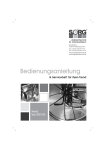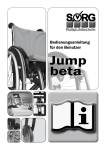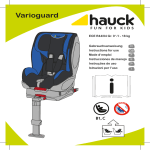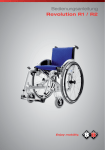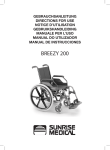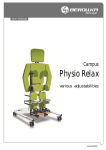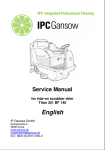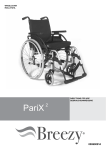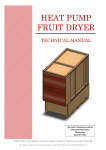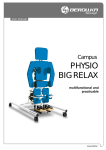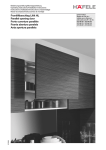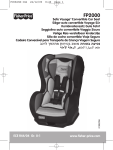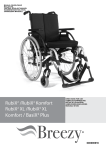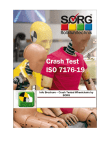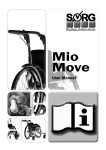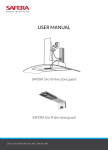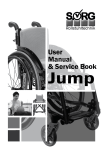Download Bedienungsanleitung englisch Muby
Transcript
User manual of Siro II page 2 of 43 We are a company-member of rehaKIND e.V. International Support Group for the Rehabilitation of Children and Young People Editor: Bernhard Wendel Technical collaborator: Bernd Rothardt As at March 13 Technical alterations and misprints excepted. SORG Rollstuhltechnik GmbH + Co.KG Benzstraße 3 D-68794 Oberhausen-Rheinhausen Fon +49 7254 - 9279.0 Fax +49 7254 - 9279.10 [email protected] www.sorgrollstuhltechnik.de © All texts and pictures are subject to copyright and may not be published - not even as an excerpt! - without the explicit authorization of SORG Rollstuhltechnik GmbH + Co.KG © translated by: www.my-translator.biz User manual of Siro II page 3 of 43 1. Contents 1. 2. 3. Contents Preface General advice 3.1 Functional purpose 3.2 Mark of SiroII 3 7 8 8 8 4. Safety precautions 9 5. Handling 5.1. Completion of use condition 5.2. Unfolding the chair 5.3. Folding up the chair 5.4. Loading and transport 5.5. Getting in and out the chair 5.6. Transporting the wheelchair 5.7. Rolling off 5.8. Carrying 13 13 13 14 15 15 16 16 16 6. Brakes 6.1. Standard knee lever brakes 6.2. Knee lever brakes - braked lockable 6.3. Knee lever brakes - braked and unbraked lockable 6.4. Brake lever lengthening Safety precautions and advice for your orthopaedic mechanic master 6.5. Drum brakes Advice for your orthopaedic mechanic master 17 17 17 17 17 18 19 19 7. 21 21 22 22 22 22 22 23 23 24 24 Adjustment of wheel postions 7.1. Punch plate and camber 7.2. Alteration of the centre of gravity’s position 7.3. Adjustment of seat-tilting 7.4. Critical height of obstacle 7.5. Static stability Safety precautions and advice for your orthopaedic mechanic master 7.6. Adjustment of front wheel Advice for your orthopaedic mechanic master 7.7. Supporting wheel (overturning protection) Advice for your orthopaedic mechanic master User manual of Siro II page 4 of 43 8. Wheels 8.1. Driving wheels 8.2. Grip rings 8.3. Spoke cover 8.4. Wheel cover 25 25 25 26 26 9. Seatback 9.1. Backrest 9.2. Seatback cover cloth standard 9.3. Seatback cover cloth restretchable 9.4. Fixed seatback 9.5. Lateral truss pads 9.6. Seatback inclination with notch system 9.7. Headrests 9.8. Stabilizing rod 27 27 27 27 27 28 28 28 28 10. Sliding handles 10.1. Extendable sliding handles / One-handed sliding handle 10.2. Sliding handles with sliding pole Safety precautions 29 29 29 29 11. Seat 11.1. 11.2. 11.3. 11.4. 31 31 31 31 32 Fixed seatFix Seat extension Bolting device Seat cover cloth 12. Side parts 12.1. Side parts 12.2. Arm pads 33 33 33 User manual of Siro II page 5 of 43 13. Leg supports Advice for your orthopaedic mechanic master 36 36 14. Further options 14.1. Therapy table 14.2. Safety belt 14.3. Tilt clip 14.4. Extension parts of other concerns 37 37 37 37 39 15. Cleaning and maintenance 16. Warranty statement 16.1. Quality assurance system 16.2. Design life 16.3. Working life 16.4. Complaints 16.5. Data plate 41 43 43 43 43 44 44 17. Warranty clauses 18. Compliance statement 19. Warranty of delivery 19.1. Assemblage and inspection 19.2. User-chronology 19.3. Handing over Please make sure that the concerning items are filled out 20. List of maintenance 21. List of repair works 45 47 48 48 48 48 49 51 User manual of Siro II page 6 of 43 User manual of Siro II page 7 of 43 2. Preface Dear Customer, today, your child has met its new “daily companion” for the first time. A companion that would never let your child down and that will accompany him/her through thick and thin. Day after day, month after month, year after year. The most important precondition for such a cheerful and safe companionship is a sensitive reaction against all individual needs. We want to be such a reliable companion to your child. Therefore, we use our years of experience and we take a lot of care over development and assemblage. This is the only way for us to guarantee the permanent best quality, individuality and safety. After having been certified according to DIN EN ISO 9001:2000, we are under the obligation to continue this standard of quality perpetually. With a measurable result! Special people need special solutions. This is why we are developing mobilization solutions, all being as unique as their user. Therefore it may happen that some descriptions slightly differ from your child’s wheelchair because we’re on the road of permanent development and this individual variant may be not yet included in this user manual. Our specialist staff or your intermediary medical service centre will be pleased to answer all your questions about the handling. Please keep this service paper in a safe place and have filled out the required data on page 44. It will be proof of regular inspections, which might be decisive in case of a warranty claim. Moreover, it will be an important source of information for the costbearer in the event of the wheelchair’s further use. For a reliable use of the new wheelchair, please read the following sections carefully and pay attention to our advice and instructions for your child’s safety! More questions? Please consult our proficient staff, they’ll be pleased to help you! Service phone +49 07254 / 9279-0 Hugo Sorg, Managing director User manual of Siro II page 8 of 43 3. General advice This user manual has been drawn up not only for you but also for your orthopaedic mechanic master of the medical service centre – specialists who are able to adjust the wheelchair exactly to your individual needs and who will complete the wheelchair’s use-state. Therefore, this user manual includes instructions which you may in no circumstances carry out yourself – improper action will always be a risk to you, the user and your environment. Please take some time to read this user manual carefully and keep it in a safe place. 3.1 Verwendungszweck Unsere Rollstühle und Sitzschalen-Fahrgestelle dienen ausschließlich gehunfähigen und geh- oder geistig behinderten Menschen zum individuellen Gebrauch bei Selbst- und/oder Fremdbeförderung. Jede andere Verwendung gilt als nicht bestimmungsgemäß. 3.2 Merkmale des Siro II: Das Besondere an Siro II ist die Möglichkeit, die komplette Sitz-Rücken-Einheit um 30° zu kanteln, das heißt, dass man den Sitz im Neigungswinkel verändern kann. Ebenso und gleichzeitig kann man bei Siro II auch den Rückenwinkel um 40° verändern bzw. den Rücken zum Transport nach vorne umklappen. Für die Veränderung des Sitzwinkels (die Kantelung) ist Siro II so konzipiert, dass sich der Schwerpunkt des Rollstuhls nur unwesentlich verändert, weil die komplette SitzRücken-Einheit beim Kanteln gleichzeitig etwas nach vorne rutscht. Diese therapeutischen Vorteile des Siro II s bergen leider auch Risiken für die Sicherheit des Benutzers, die man kennen muss, um sie beherrschen zu können. In dieser Gebrauchsanweisung wollen wir Sie über diese Risiken aufklären und Ihnen eine Handreichung zum sicheren Umgang im therapeutischen Alltag geben. Die wichtigsten drei seien gleich hier erwähnt: • Betätigen Sie bitte NIEMALS den Kantel-Mechanismus während der Fahrt des Rollstuhls! • Fahren Sie bitte NIEMALS den Siro II im gekantelten Zustand oder mit gestrecktem Rücken ohne Kippschutz (Sicherheitsrad)! • Fahren Sie bitte NIEMALS den Siro II mit maximaler Rückenneigung und gleichzeitiger maximaler Kantelung! Viele Sicherheitsaspekte in dieser Gebrauchsanweisung wiederholen wir nahezu "gebetsmühlenartig". Wenn Sie aber die Gebrauchsanweisung sorgfältig gelesen haben, werden Sie die Gründe gut nachvollziehen können, denn wir wollen, dass Sie und/oder Ihr Kind sich wirklich absolut sicher fühlen können im neuen Siro II. User manual of Siro II page 9 of 43 3.1 Optionale Veränderungen Weil kein Mensch dem anderen gleicht, sind wir in unseren Standards so vielfältig wie nur irgend möglich, um somit Ihren völlig individuellen Bedürfnissen gerecht werden zu können. Deshalb empfehlen wir Ihnen aus unserer langjährigen Erfahrung heraus die folgenden baulichen Veränderungen an Ihrem Rollstuhl: • bei einem Benutzergewicht über 90 kg eine verstärkte Lochplatte aus Stahl; • bei einem Benutzergewicht über 90 kg oder bei einer SB/ST über 44cm eine zweite Gasdruckfeder zur leichteren Sitzkantelung des Stuhls; • bei nicht aktiven Benutzern die weniger wartungsintensiven 12"-Räder; • bei sehr aktiven Kindern oder Benutzern eine Kindersicherung am Auslösehebel für die Sitzkantelung User manual of Siro II page 10 of 43 4. Safety precautions When developing and manufacturing our wheelchairs, we set great store by safety. In order to maintain this high quality of safety in everyday life, it is in your own and your child’s interest to carefully pay attention to the following rules. Improper use could cause a hazardous situation to you and your child and our assurance of warranty would no longer be valid. Viele Sicherheitsaspekte wiederholen wir in dieser Gebrauchsanweisung nahezu "gebetsmühlenartig". Wenn Sie aber die Gebrauchsanweisung sorgfältig gelesen haben, werden Sie die Gründe gut nachvollziehen können, denn wir wollen, dass Sie und/oder Ihr Kind sich wirklich absolut sicher fühlen können im neuen Siro. Die folgende Vorgehensweise, um ggf. Ihr Kind mit dem neuen Rollstuhl vertraut zu machen, gilt natürlich in modifizierter Form auch für erwachsene Benutzer. Aber aus Gründen der Einfachheit beschreiben wir die Situationen im Folgenden immer aus der Perspektive eines (sehr) jungen Benutzers. Familiarizing with Siro II • Take your time to familiarize yourself and your child with the new situation. Be very patient and use caution to make sure that your child will feel safe in its new wheelchair. Because Muby is an activity-wheelchair whose limits you’ll have to get to know. You should really let your child undergo these limits quite literally. Make sure that during the following steps both of you are safeguarded by an experienced and strong assistant! • Lock the parking brakes and the drum brake and put your child into Siro II. • Carefully practise the wheelchair’s behaviour on shifting the centre of gravity in all 4 directions! Make your child reach for objects, holding them further and further. • Sensitize your child for these changed situations and ask if something changes, and what exactly. And do not forget to express clearly that you will now intensify the situation. • In any case, this must all be practised without fear. Do not force the learning process! • Only after your child has been familiarized with the wheelchair’s static stability in its standstill position, you should risk trying out the wheeling behaviour. • Children soon understand how to drive a wheelchair, it nearly is an automaticity. The process of braking down however, needs thorough practice because it is dangerous! Tell your child in clear terms that the knee lever brake is NOT designed for braking down the wheelchair’s speed and that it may fall out of the chair. User manual of Siro II • page 11 of 43 Your child must learn that it should only use the grip rings for braking down the wheelchair. Set Siro II in a slow motion and make the child brake down the wheelchair to the standstill position with its palm on the grip rings. In doing so, the child should keep in mind what will happen as it reaches between tyre and grip ring (as far as the wheelchair is not equipped with our Rehavolution-wheels). If your child has got delicate hands, please give it some gloves, eg. for cycling, meaning with a leather inside – in no case mitts nor woolen gloves! (Never forget that strong friction will heat up the grip rings. Therefore, either wear some gloves or use the grip ring coating. Your medical assistant will be pleased to give you some advice.) • • • As your child has thoroughly been familiarized with the items „centre of gravity“ and „brakes“, you may carefully begin with the next items. At first, repeat the above exercises in the open country on even territory and only after that on gradients and slopes and always with another assistant. It is most important to create a situation your child is not afraid of. But: do never “play” dangerous situations, eg. by tilting the chair and then catching it meaning it to be a joke… Only real-life dangers may be mastered by your child. Further safety precautions • Die Gefahr des Umkippens wird bei Siro II durch die Möglichkeit der Verstellung des Sitzwinkels und/oder des Rückenwinkels erheblich verstärkt! • Aktivieren Sie deshalb niemals die Sitzkantelung während des Fahrens, sondern bringen Sie zu diesem Zweck den Siro II immer zuerst in einen absolut gesicherten Stillstand mit der Feststellbremse plus, falls vorhanden, der Trommelbremse. • Aktivieren Sie vor jeder Sitzkantelung oder Rückenlehnenverstellung immer und unbedingt zuerst den Kippschutz (Sicherheitsrad) und lassen Sie unbedingt das Sicherheitsrad während der Fahrt aktiviert! • Examine the braking efficiency of the parking brake (knee lever brake) each time your child wheels off. Only when the driving wheels show adequate air pressure, the brake will work perfectly. Versuchen Sie zu diesem Zweck, den Siro II • bei geschlossenen Feststellbremsen zu schieben. Die Räder dürfen maximal im blockierten Zustand über den Boden rutschen. • Please also keep in mind that wet or dirty tyres may considerably reduce the braking efficiency. Never change the parking brakes’ adjustment on your own authority because a wrong distance between brake unit and tyre may eliminate the braking efficiency completely. In this case, please consult your intermediary medical service centre immediately and have a qualified orthopaedic mechanic taken care of the problem. • The parking brake (knee lever brake) is designed for blocking the wheels and not for braking down the wheeling chair. Such improper use could cause a serious hazardous situation your child and its environment! • Each time your child wheels off, you will have to check if the driving wheels’ User manual of Siro II • • • • • • • • • • • • • page 12 of 43 plug-in axles have been thoroughly tightened. Your child may never use the foot rest(s) or leg supports for getting in or out the wheelchair. The chair may turn over forewards. Lock the parking brake each time your child gets in or out the wheelchair. If possible, always use the supporting wheel. Especially when wheeling on gradients or slopes, on uneven territory or thresholds, the danger of turning over is really high. When wheeling in public traffic, keep in mind that you must act according to Road Traffic Act. In order to avoid accidents, you should always control if the reflectors are tidy and both of you should wear bright colours to be well seen. The wheelchair may not be carried together with its occupant but may only be wheeled. When transporting the wheelchair in a vehicle, your child may only sit in the chair as the chair is fixed onto the required devices. (see handling – transporting the wheelchair p.16). Have the wheelchair serviced regularly by a qualified medical service centre. It is necessary to examine if all screws are properly tightened, if welded joints show any damage and if signs of wear can be detected. Your child should get over steps and stairs only with an assistant. Take care that the supporting wheel is swung in and that the assistant(s) always uses the fixedly screwed metal parts of the wheelchair for carrying, because the sliding handles’ rubber caps may unexpectedly come off and cause serious accidents! In order to avoid injuries, your child should not take its hand between the driving wheels and knee lever brake or wheel cover. Do not wheel on gradients over 4°; meaning ca. 7%. The danger of overturning increases on gradients over 4°. An occupied wheelchair should never be left unsupervised on a slope, not even with locked knee lever brake. With an active (swung out) supporting wheel, the max. critical obstacle height is ca. 3 cm. The max. useful vehicle load capacity is 100 kg. The standard frame is not equipped for more weight. User manual of Siro II page 13 of 43 5. Handling 5.1 Completion of use condition The wheelchair will be in working order for everyday life after having examined the following basic items: • do the parking brakes show functional performance? • do the drum brake show functional performance? • are the plug-in axles thoroughly snapped in the adapters? • are the steering wheels in working order and may they be easily rotated? • do the driving wheels show adequate air pressure? • is the supporting wheel in working order? • is the fixed seat shell thoroughly locked into the securing devices at the back? • is the seat shell in perfect condition? • is the seat shell fest im Sitzschalen-Tragerahmen arretiert? • is the seat-tilting unobjectionable working? • is the gas pressure spring in working order? • Sitzt der Bowdenzug am Auslösehebel der Kantelung fest in seiner Aufhängung? 5.2 Kantelung der Sitz-Rücken-Einheit • Um den Siro II zu kanteln, das heißt, die komplette SitzRücken-Einheit um bis zu 30° im Winkel nach hinten zu kippen, schließen Sie zunächst die Feststellbremse and the drum brake. • Dann betätigen Sie den Auslösehebel am Schiebegriff bzw. am Schiebebügelgriff, halten ihn im gezogenen Zustand und schieben mit leichtem Druck den Sitz gleichzeitig nach vorne und nach unten. • Beachten Sie bitte, dass die Gasdruckfeder Ihrem Druck entgegenwirkt und Sie deshalb die Sitzkantelung bei leerem Siro II selbst kaum oder nur sehr schwer bewerkstelligen können. Dies ist kein Defekt, sondern ein Zeichen dafür, dass die Gasdruckfeder voll funktionstüchtig ist. • Im Gegenteil wäre eine leicht zu betätigende Gasdruckfeder bei einem leeren Stuhl ein Indiz dafür, dass sie den Anforderungen bei Belastung nicht mehr gewachsen ist und deshalb unverzüglich ausgetauscht werden muss. Denn eine defekte Gasdruckfeder stellt bei der Kantelung ein erhebliches Sicherheitsrisiko dar, weil Ihnen der Sitz mit Insasse unvermittelt und ungefedert nach unten plumpsen kann. • Um den Sitz wieder in seine wagerechte Position zu versetzen, Schließen Sie wieder die Feststellbremse. • Ziehen Sie dann wieder den Auslösehebel und ziehen die Sitz-Rücken-Einheit mit leichtem Zug nach oben bis sie die gewünschte Position erreicht hat. • Beachten Sie bitte, dass Sie den Sitzwinkel bei Siro II bis auf - 5° absenken können. User manual of Siro II page 14 of 43 5.3 Einstellung des Rückenwinkels auf die Sitzschale • Um den Rücken im Winkel exakt auf die Sitzschale einzustellen, befolgen Sie bitte die Schritte auf S. 23 • Um den Rücken für den Transport nach vorne umzulegen, bringen Sie zunächst die ausziehbaren Schiebegriffe bzw. den Schiebebügelgriff auf die niedrigste Position. • Drücken Sie dann, wie auf S. 23 beschrieben, die Querstange, entriegeln die Arretierungsbolzen und legen den Rücken nach vorne um. • Um den Rücken wieder zurück zu stellen, verfahren Sie bitte analog. 5.4 Getting in and out the chair Achten Sie beim Ein- und Aussteigen darauf, dass die Feststell- und die Trommelbremsen fest angezogen und die Fußplatte/n hochgeklappt ist/sind. Lassen Sie sich von einer Begleitperson die Lenkräder nach vorne drehen oder fahren Sie selbst mit Ihrem Stuhl soweit rückwärts, dass die Lenkräder nach vorne gedreht sind und schließen dann die Kniehebelbremse. Das verleiht dem Stuhl beim Ein- und Aussteigen noch etwas zusätzliche Stabilität. Vermeiden Sie bitte, sich auf die Fußplatte zu stützen, da sonst der Rollstuhl nach vorne kippen kann. Zum Kippen kann es ebenfalls kommen, wenn Sie sich mit ihrem Körper zu weit aus dem Rollstuhl lehnen und somit den Schwerpunkt ändern. Lesen Sie dazu ggf. noch einmal die S. 9 ff. Seien Sie sich bewusst, dass Sie nach jeder Veränderung der Radposition andere Balance-Verhältnisse haben und machen Sie sich durch entsprechende Versuche ebenfalls nur in Anwesenheit einer Hilfsperson! - damit vertraut. Nur Gefahren, die Ihnen bewusst sind, können Sie auf Dauer wirklich vermeiden! User manual of Siro II page 15 of 43 5.5 Verladung und Transport 5.5.1 Sitzschale Bevor Sie die Sitzschale abnehmen wollen, stellen Sie die Räder mit den Kniehebel- und den Trommelbremsen fest und bringen den Sitzschalen-Tragerahmen immer in die waagerechte Position. Nehmen Sie die Sitzschale aus der Keilaufnahme, indem Sie den Auslösehebel der Keilaufnahme an der Rückseite des Stuhls nach unten und die Sitzschale nach vorn schieben. Zum Wiedereinsetzen setzen Sie die Sitzschale auf den Bolzen der Keilaufnahme und richten den Keil horizontal nach der Keilaufnahme aus. Dann können Sie die Sitzschale nach hinten schieben, bis sie in der Keilaufnahme fest sitzt; der Sicherungsbolzen schnappt dabei hörbar ein. Vergewissern Sie sich auf jeden Fall, dass der Sicherungsbolzen eingerastet ist! Klappen Sie die Beinstütze hoch und bringen Sie ggf. die Beinstützenhalter in eine senkrechte Stellung. 5.5.2 Schiebebügel / Rücken Lösen Sie mit Hilfe der Klemmhebel oder Sterngriffschrauben die ausziehbaren Schiebegriffe, schieben diese dann so weit wie möglich ein und klemmen sie wieder fest. Die Bügelgriffe lassen sich durch Lösen der Sterngriffschrauben an den beiden BügelEnden in die gewünschte Raststellung drehen (siehe auch S. 33). Klappen Sie die Rückenlehne mit den Schiebebügelgriffen nach vorn, indem Sie die Querstange am unteren Ende der Rückenrohre nach unten drücken. Auch hier achten Sie beim Wiederaufbau bitte darauf, dass die Sicherungsriegel auf beiden Seiten sicher eingerastet sind. Bei Rückenlehnen mit Verstellung durch Gasdruckfeder hängen Sie diese durch ziehen des Kugelsperrbolzens aus und klappen Lehne und Gasdruckfeder nach vorn um. 5.5.3 Antriebsräder Um die Antriebsräder per Steckachse abzunehmen, lösen Sie die Bremsen und drücken auf den kleinen Knopf, der aus der Mitte der Steckachse herausragt und ziehen das Rad mit gedrücktem Knopf heraus. Beachten Sie bitte grundsätzlich, dass die Steckachsen sehr empfindlich sind. Vor dem Wiedereinsetzen der Räder überzeugen Sie sich, dass die Feststellbremsen geöffnet sind. 5.5.4 Trommelbremse Wenn Sie bei Ihrem Siro die Räder abnehmen, liegen anschließend die Bremsbacken der Tommelbremse ungeschützt frei. Achten Sie bitte darauf, dass die empfindlichen Bremsbacken nirgendwo anstoßen und/oder beschädigt werden. User manual of Siro II page 16 of 43 5.6 Transporting the wheelchair First of all we have to point out that transporting a person sitting in a wheelchair signifies a considerable security risk! In principle, a wheelchair may only be transported unoccupied! Therefore, transporting and securing a wheelchair in a vehicle, with or without occupant, is always at your own risk. SORG Rollstuhltechnik GmbH + Co.KG will not be liable for injured people or damaged materials, resulting from such a transport. At its immovable points the unoccupied wheelchair must be secured in the vehicle with suitable securing devices, so it will not put passengers in danger in case of a sudden brake manoeuvre! In order to transport a wheelchair as instructed, it must absolutely be equipped with an AMF-system or a similar retention system with MOT-certificate (Technical Authority Inspection). In addition to this, the vehicle must be equipped with a headrest, firmly connected with the vehicle, as well as with an integrated person retention system on the basis of three point seatbelt if the wheelchair is to be transported together with its occupant. More questions? Do not hesitate to contact us, just give us a call: service phone +49 7254-92790. We will be pleased to give you advice and to refit your Siro II if necessary. 5.7 Rolling off Zuerst bringen Sie den Siro II in eine senkrechte Sitzposition. Dann kippt die Begleitperson den Rollstuhl am Ankippbügel an und zieht ihn rückwärts mit den Schiebgriffrohren am Hindernis hoch. Sicherheitshinweise: Auf keinen Fall an der Schiebestange oder dem Schiebebügelgriff hochziehen. Der Schiebebügelgriff könnten aus Versehen nicht richtig festgezogen sein, wodurch sich der Rollstuhl vom Griff lösen und es zu schweren Verletzungen kommen kann. Zur Sicherheit sollte eine zweite Person unterhalb des Rollstuhls am Rahmen (nicht an den Beinstützen!) den Vorgang unterstützen und absichern. 5.8 Carrying Your child should, together with its wheelchair, be carried by an assistant only in extremely seldom exceptions. To the most part it will be easier rolling off the wheelchair over the obstacle with its driving wheels! And if it really should be unavoidable, only frame and back tubes are suited for carrying. Safety precautions: The extendable sliding handles, as well, may in no circumstances be used for carrying the wheelchair. When wheeling with your chair, never use escalators! Not even with an assistant and especially not being carried! Department stores and public institutions with escalators always have suitable elevators. User manual of Siro II page 17 of 43 6. Brakes 6.1 The knee lever brake is a parking brake for blocking the wheels and may in no circumstances be used for braking down the wheelchair’s speed! Each wheelchair is equipped with two knee lever brakes. These only have the purpose of blocking the wheels in their standstill position. They are not designed for braking down the wheeling chair. For this, your child should always use the grip rings and it is also possible for you to deal with this, using the drum brake. Please, keep in mind that strong friction will considerably heat up the aluminium grip rings. For your child’s and your own safety, always take care that the brakes are working perfectly. Low air pressure, rainy and wet days, bad treads and a distance too large between brakes and tyres, all may have an effect on the functional performance of the brakes. 6.2 Knee lever brake - braked lockable (as option) The same function as above, yet, in addition lockable by a safety bolt. For securing the knee lever brake in brakedstate, lock the brake. The bolt will be interlocked as far as it is not pulled out and turned by 90°. For releasing the brake again, pull out the safety bolt and at the same time open the brake. 6.3 Knee lever brake – braked and unbraked lockable (as option) The same function as above, yet, in addition lockable by a red safety bolt in every position. This bolt locks automatically in braked- or unbraked-state. To actuate the brake, you only have to unburden the brake lever and pull the bolt outwards to get the brake in the needed position. After that the bolt again locks automatically and so it prevents a change of the brake position. 6.4 Brake lever lengthening (as option) In case the brake is correctly adjusted but the operation lever may no longer be reliably operated by manual power, in no circumstances you may change the distance between brake dowel and tyre! In this case, your child will need our brake lever lengthening and your medical centre will be pleased to equip the wheelchair with it. Please take care that your child is not sitting on the lengthening – danger of breakage User manual of Siro II page 18 of 43 Safety precautions: • Take care that the tyres always show correct air pressure. Low tyre pressure is not only a needless obstruction for easy wheeling, it above all reduces the parking brakes’ functional performance considerably and their operation function may even be eliminated completely. • Always take care that the brakes have to operate reliably. Especially when wheeling on slopes, it must be ensured at any time that the wheelchair will stand still when the brakes are locked. • Keep in mind that on rainy and wet days and as the chair is dirty, the braking operation is considerably changed and reduced. • After each adjustment of the wheel positions as well as after each tyre-change, the brakes must be adjusted anew. Have the knee lever brakes adjusted by a qualified medical service centre. Advice for your orthopaedic mechanic master: For adjusting the brake as the tyres are properly inflated, both filister head screws (A+B), fixing the brake on the brake support, must be loosened (max. air pressure on the outer tyre). The brake must be adjusted in such a way that with a released brake on 1“-tyres a distance (s) of ca. 15-18mm between brake dowel and tyre surface exists and a distance of ca. 12-15mm on 1 3/8“tyres. Re-fix the brake in this position with the filister head screws. Now do a test on it: the brakes should block the wheel thus far that the occupied chair can no longer be wheeled. The wheelchair will instead skid across the floor with blocked wheels. User manual of Siro II page 19 of 43 6.5 Drum brakes In contrast to the parking brake, the drum brake may be used for braking down your speed. In addition, our drum brakes have a locking-mechanism with whom they can be braked in their maximum braking-state. (as an option, a childproof safety catch is available as well) • • • • • Please keep in mind that the drum brake on its own is not suited for a reliabale securing of the wheelchair, eg. on slopes. The brake pull rod may unexpectedly be torn, resulting in bad accidents. Hence, for your child’s safety, take special care that when locking the drum brake, the parking brake (knee lever brake) must always be activated as well! Drum brakes have delicate adjustment alternatives and they require some service and maintenance, however, they are not dependent on air pressure. In the second lock-in position of the brake lever, the brake should be so firmly fixed that the occupied wheelchair may no longer be wheeled (the wheelchair will instead skid across the floor with blocked wheels). Please have the drum brakes regularly serviced by your intermediary medical service centre. Advice for your orthopaedic mechanic master: The adjustment of the drum brake is effected by a set screw on the lower end of the brake pull rod. The brake is adjusted by turning the set screw counter-clockwise. 6.6 Rückrollsperre (optional) Diese dient dazu, den Rollstuhl z.B. beim Befahren einer Steigung gegen ungewolltes Zurückrollen zu sichern. Um die Rückrollsperre zuzuschalten, klappen Sie den Mechanismus an der Kniehebelbremse einfach nach hinten, Richtung Antriebsrad, sodass die Rolle der Rückrollsperre auf dem Mantel des Rads liegt. Wenn Sie jetzt, z.B. an einer Steigung, dem Rolli keinen Schub mehr geben, blockiert die Rückrollsperre automatisch die Räder. Die Blockierkraft beträgt bei 7° Steigung maximal 90 kg und verringert sich mit zunehmender Steigung. Um die Rückrollsperre wieder zu deaktivieren, klappen Sie den Blockiermechanismus einfach wieder nach vorne oben. Dringender Sicherheitshinweis: Reinigen Sie bitte nach jedem Gebrauch die Rolle gründlich von Sand, Schmutz, etc., damit sie beim nächsten Einsatz nicht etwa durch Rückstände außer Funktion gesetzt wird. Das könnte Sie in ganz erhebliche Gefahr bringen und unter Umständen schwer verletzen. User manual of Siro II page 20 of 43 7. Sitzschale – Rücken Die folgenden Veränderungen sollten Sie bitte unbedingt von einem qualifizierten Sanitätsfachhändler vornehmen lassen, um die Funktionstüchtigkeit des Stuhls, seinen therapeutischen Nutzen und vor allem Ihre Sicherheit gewährleisten zu können. 7.1 Anpassen der Standard Rückenlehne Die Standard-Rückenlehne beim Siro II kann durch Lösen der Schrauben (A) stufenlos von 90°-120° dem festen Sitzschalenwinkel angepasst werden. Die Schrauben müssen nach der Einstellung wieder fest angezogen werden. Beachten Sie dabei, dass sich beim Verstellen der Rückenlehne der Schwerpunkt des Rollstuhles verlagert. (Siehe dazu auch 9.1 S.25) Wir raten daher dringend, den Schwerpunkt bei der hinteren (der am wenigsten steilen) 120° Stellung der Rückenlehne plus der max. Kantelung zu bestimmen. Dann sind Sie bezüglich des Schwerpunkts immer auf der sicheren Seite. 7.2 Anpassen der Rückenlehne mit Gasdruckfeder Das Rückenteil der Sitzschale wird auf beiden Seiten mit Verriegelungswinkeln ausgerüstet, in welchen arretierbare Rastbolzen eingeschraubt sind. Die Rastbolzen werden bei der mit Gasdruckfeder verstellbaren Rückenlehne an beiden Rückenrohren in die Führungen auf der Innenseite eingerastet. Dadurch R as t bo lz en wird beim Verstellen des Rückenwinkels das Sitzschalenrückenteil automatisch mitgeführt. Zum Entnehmen der Sitzschale sind die Rastbolzen zu entriegeln und zu arretieren. Beim Einsetzen der Sitzschale müssen Sie dann in umgekehrter Reihenfolge verfahren. U K S it z s c ha le User manual of Siro II page 21 of 43 8. Sitzschalenadapter 8.1 Befestigen der Sitzschale auf dem Tragerahmen Bevor Sie die Sitzschale auf dem Tragerahmen befestigen, schließen Sie bitte unbedingt die Kniehebel- und Trommelbremse und bringen den Sitzschalenadapter anschließend über den Kantel-Mechanismus in eine waagerechte Position. Setzen Sie dann die Sitzschale auf den Bolzen des Adapters (waagerecht), wodurch der Bolzen der Keilaufnahme entriegelt wird. Schieben Sie nun die Sitzschale nach hinten, bis der Verriegelungs-Bolzen der Keilaufnahme hörbar einrastet. Testen Sie dann, ob die Sitzschale auch fest im Adapter arretiert ist, indem Sie versuchen, die Sitzschale von hinten (möglichst weit unten) aus dem Adapter zu schieben. 8.2 Lösen der Sitzschale Sie können die Sitzschale natürlich nur dann vom Adapter lösen (z.B. wenn Sie den Siro für den Transport klein machen wollen), wenn sie nicht fest mit den Sitzschalen-Tragerahmen verschraubt ist. Bevor Sie die Sitzschale abnehmen wollen, stellen Sie die Räder mit den Kniehebelund den Trommelbremsen fest und bringen den Sitzschalen-Tragerahmen immer in die waagerechte Position. Nehmen Sie die Sitzschale aus der Keilaufnahme, indem Sie den Sicherungsbolzen mit dem Auslösehebel an der Rückseite des Rollstuhls nach unten drücken und die Sitzschale nach vorn schieben. User manual of Siro II page 22 of 43 9. Einstellung der Radpositionen 9.1 Lochplatte und Radsturz Die folgenden Veränderungen sollten Sie bitte unbedingt nur von einem qualifizierten Sanitätsfachhändler vornehmen lassen, um die Funktionstüchtigkeit des Stuhls, seinen therapeutischen Nutzen und vor allem Ihre Sicherheit gewährleisten zu können. Die Position der Antriebsräder bestimmen im Zusammenspiel mit den Lenkrädern die Sitzhöhe, das Sitzgefälle sowie die Lage des Schwerpunktes und damit die Handhabung des Rollstuhls insgesamt. Vor dem Hintergrund der äußerst sensiblen Schwerpunktsituation beim Siro II durch die mögliche Kantelung, empfehlen wir Ihnen dringend, auf eine Veränderung des Sitzgefälles über diesen Weg zu verzichten. Die Position der Antriebsräder im Zusammenspiel mit den Lenkrädern bestimmen die Sitzhöhe, das Sitzgefälle sowie die Lage des Schwerpunktes und damit die Handhabung des Rollstuhls insgesamt. Sie können die Adapter für die Steckachsen der Antriebsräder vertikal in mehreren Positionen der Lochplatte befestigen, um den Radgrößen anzupassen oder die Sitzhöhe zu beeinflussen. Auch horizontal können Sie diese in unterschiedliche Positionen bringen, womit Sie die Lage des Schwerpunkts und damit die Kippsicherheit des Rollstuhles verändern können. Werkseitig justieren wir das Sitzgefälle auf 0°. Ein anderes Sitzgefälle ist sehr leicht über die Kantelung der kompletten Sitz-Rücken-Einheit zu erreichen. Um dennoch die Sitzhöhe oder den Grundsitzwinkel zu beeinflussen, empfehlen wir Ihnen, den Siro nachträglich mit einer Radstandsverlängerung ausstatten, damit sich der Schwerpunkt nicht ungünstig nach hinten verlagert. Unsere Lochplatte ist so konzipiert, dass Sie jederzeit zwischen Standardund 12"-Rädern wechseln können, ohne dabei die Lochplatte wechseln zu müssen. Bringen Sie dafür einfach den Steckachsen-Adapter in die gewünschte Position. Beachten Sie, dass die Schnorr-Sicherungsscheibe nur einmal verwendet werden soll. User manual of Siro II page 23 of 43 Weiterhin besteht die Möglichkeit, den Radsturz zu verändern. Dieser dient der Seitwärtsstabilität, zum Schutz der Finger vor Quetschungen bei engen Durchgängen und zur besseren Erreichbarkeit der Greifringe. Hierzu entfernen oder ergänzen Sie einfach die Abstandhalter zwischen Rahmen und Lochplatte. Achten Sie bei allen Veränderungen der Antriebsrad-Position darauf, dass der Schwerpunkt nicht zu weit nach hinten wandert, dass die Bremsen einwandfrei funktionieren. Testen Sie die neue Radposition immer vorsichtig mit Stützrad und einer Hilfsperson, damit Sie sich an das neue Fahrverhalten des Rollstuhls gewöhnen können und ein Umkippen verhindert wird. 9.2 Alteration of the centre of gravity’s position Fundamentally, Siro’s centre of gravity is situated in front of the wheelchair’s rear axles. The distance between centre of gravity and rear axles is decisive on the handling and the safety of the chair. If the axles are right behind the centre of gravity, the child will wheel and manoeuvre much easier, yet the danger of overturning increases, above all if the chair is tilted! Deshalb orientieren Sie sich bei jeder Veränderung der Radposition am größtmöglichen Neigungswinkel des Rückens, also daran, wenn der Rücken maximal nach unten geklappt und zusätzlich die Sitzeinheit gekantelt ist. Benutzen Sie dann beim Testen der Kippstabilität unbedingt die Sicherheitsräder und lassen sich von einer erfahrenen und kräftigen Begleitperson dabei assistieren. Der Schwerpunkt muss so eingestellt werden, dass bei maximalem Neigungswinkel und der Originalbelastung die Sicherheitsräder nicht den Boden berühren. Mit der Radstandverlängerung können Sie den Schwerpunkt des Siro II um 125 mm nach hinten verlagern und die Kippsicherheit erhöhen. Allerdings vergrößert sich dadurch auch der Wendekreis. 9.3 Critical height of obstacle Siro’s critical height of obstacle, with an activated supporting wheel is at the best ca. 2.5 cm. 9.4 Static stability Siro’s static stability is 4°, i.e. ca. 7%. On steep slopes, the wheelchair together with its occupant may tilt over and your child may be injured badly! Safety precautions: Fundamentally, your child may turn over backwards in its wheelchair as it is getting over an obstacle. This depends on the wheelchair’s centre of gravity and on the height of obstacle. Please always make sure that an assistant is helping and safeguarding the child as it wants to get over high obstacles, e.g. stairs and thresholds. User manual of Siro II page 24 of 43 Advice for your orthopaedic mechanic master: On trying out different positions of the rear wheels, use the supporting wheels on your first trials and test the behaviour of the centre of gravity at best together with a strong helper who will safeguard your tests. Beachten Sie bitte auch die veränderte Situation bei Kantelung. 9.5 Adjustment of front wheel The following alterations should only be carried out by a qualified medical centre, in order to ensure the wheelchair’s functional performance, its therapeutical usefulness and especially your safety. On changing the extension of the steering wheel onto the frame, the seatangle may be changed as well. Take care on all alterations that exactly the same adjustments are carried out on both sides, that the centre of gravity is not shifted too far backwards (danger of overturning) and that the rotation performance is not obstructed by the leg support. Please remember to adjust the correct position of the front wheel adapter after each modification of the wheel size, of the wheel base etc., otherwise the perfect wheeling function of the front wheels will no longer be ensured. Advice for your orthopaedic mechanic master: For adjusting the steering wheel adapter, loosen both screws (A) which are fixing the front wheel adapter onto the frame. Now the eccentric disc (B) can be turned until the front wheel adapter is in an exact perpendicular position - with a protractor the angle may be rectified. Do not forget to re-tighten all screws after having finished the adjustment! User manual of Siro II page 25 of 43 9.6 Supporting wheel (overturning protection) The purpose of the supporting wheel is to avoid turning over backwards. As depicted in the illustration, the wheel should be adjusted with a distance of 2-5cm towards the floor. For getting over a threshold, the supporting wheel must be swung in by the assistant and afterwards be swung out again; otherwise the wheelchair may not be wheeled properly. The swing jib of the supporting wheel is pivoted in the fixed fitment. In order to swing out the supporting wheel, push it down with your foot or hand and turn it by 180°. Then release it, so it may be engaged into the position slot. If you push down the jib in the fitment, it will come out of its position and may be swung back. Make sure that the jib is snapped in its end position because a loose wheel may result in an ankle injury of the assistant. Wir empfehlen Ihnen bei einem sehr lebhaften Benutzer bzw. bei einer TonusDysstabilität ein zweites Sicherheitsrad, damit Ihnen der Rollstuhl nicht ungewollt nach einer Seite umkippen kann. Ihr Orthopädiemechaniker baut es Ihnen gerne an Ihren Siro II. Auch nachträglich! Advice for your orthopaedic mechanic master: For adjusting the supporting wheel higher, loosen screw A and pull out the jib from the spring and A the fitment. Re-set screw B in the jib by the needed punch hole distance. Then assemble spring and jib into the fitment and re-tighten all screws properly. 2 - 5 cm B User manual of Siro II page 26 of 43 10. Wheels 10.1 Driving wheels Fundamentally, the driving wheels are nearly the most delicate parts of the wheelchair because many factors concerning your safety and the wheeling performance depend on them! In this connection, once again we have to point out politely, yet insistent, that the safety precautions are most important! • In case the wheelchair is equipped with pneumatic tyres, please regularly examine the air pressure (at least every 2 weeks) because the functional performance of the brakes depends on them! You’ll find details concerning the required air pressure on the outer tyre. • Examine the tyres’ tread regularly because a bad tread will not only affect the functional performance of the knee lever brake, it may even be completely eliminated in unfavourable circumstances. • This is also valid on puncture resistent tyres! • Examine regularly (at least every 3 months) if the spokes are tightened properly. If necessary, have the spokes re-tightened by your medical service centre, otherwise the wheel will be a danger. • The grip ring’s screws may loosen themselves as they are strained too much. Then the grip rings as well will be a considerable danger because they may come off and the wheelchair may not be braked down. Hence, also examine if the grip rings are tightened properly at least every 3 months and if necessary, have them re-adjusted by your orthopaedic mechanic master. • Please also examine if the spoke covers, if equipped with, are firmly fixed! Loose ends may result in injuries of your child’s hand. If you need the required clips or cable fixers, ask your medical service centre or just give us a call, we’ll send them right away; service phone +49 7254-92790. 10.2 Grip rings Strong friction will easily heat up aluminium grip rings. Some gloves are surely a good aid yet your child’s wheelchair may also be equipped with a grip ring coating, even if the chair is equipped with rehavolution wheels with integrated grip rings. On standard wheels, the grip ring extension and its distance towards the wheel rim is a variable feature. For this, the tyre must be removed from the wheel and the grip ring screws on the rim must be loosened. Then re-assemble the screws in the needed position and put the tyre back onto the rim. Please take special care that the rubber band covers the screw heads otherwise the air tube may be damaged. User manual of Siro II page 27 of 43 10.3 Spoke cover (as option) Depending on the design, the spoke cover is attached to the spokes by clips or cable fixers. For the most part, these parts may not be used twice if the spoke cover has been removed. 10.4 Wheel cover (as option) The most important purpose of the wheel cover is to protect your child’s hands from getting injured, but it will also keep off the dirt caused by the rotating driving wheels. At our works, we have adjusted the wheel cover in the optimum position. So, if you want to modify the wheel position, you will also have to re-adjust the wheel cover. For this, the screws on the wheel cover holder must be loosened, then get the wheel cover into the needed position by means of the slotted holes. Re-tighten the screws - and off it goes! In case the wheel cover holder is bent out of shape, please ask your medical service centre, so that the aluminium parts will not be broken off or the paint layer will not peel off as the part is bent improperly. User manual of Siro II page 28 of 43 11. Seatback 11.1 Rückenlehne Bei Siro II ist die komplette Rücken-Sitz-Einheit um 30° im Winkel verstellbar. Diese "Kantelung" erfolgt über eine Gasdruckfeder (optional zwei), deren Auslösehebel sich an den Schiebegriffen befindet. Standardmäßig wird Siro II mit einer Rückenbespannung ausgeliefert. Der Rücken ist serienmäßig mit einer Stabilisierungsstange ausgestattet, um die vertikale Stabilität des Rollstuhls zu optimieren. Ebenso serienmäßig kann man bei Siro II den kompletten Rücken um 40° im Winkel nach hinten verstellen und nach vorne zum Transport umklappen (siehe hierzu nochmals S.9, 15-16). Wir halten jedoch zahlreiche Optionen bereit, mit denen Sie Ihren Siro II exakt nach Ihren Wünschen ausstatten können. Diese sind hier im Folgenden alle beschrieben. 11.2 Kantelung der Sitzeinheit um 30° Die Kantelung der Sitz-Rücken-Einheit erfolgt über den Auslösehebel der Gasdruckfeder an den Schiebegriffen bzw. Schiebebügelgriff. Ziehen Sie dazu den Hebel und bringen Sie die Sitzeinheit mit gezogenem Hebel in die gewünschte Position und lassen den Hebel anschließend wieder los. Zum Aufrichten des Stuhls ziehen Sie bitte wieder den Hebel und gleichzeitig den Sitz mit den Schiebegriffen nach oben. Die Gasdruckfeder unterstützt diesen Prozess auf ideale Weise, so dass Sie dabei kaum Kraft aufwenden müssen. Dringender Sicherheitshinweis Betätigen Sie die Sitzkantelung nur bei aktiviertem Kippschutz (Sicherheitsrad), da Ihnen sonst der Rollstuhl nach hinten umkippen könnte. Betätigen Sie die Kantelung niemals während der Fahrt, da die plötzlich veränderte Schwerpunktlage zu ungewolltem Kontrollverlust führen könnte und sowohl die Begleitperson wie den Benutzer in äußerst gefährliche Situationen bringen kann. User manual of Siro II page 29 of 43 11.3 Rückenverstellung um 30° Den Rücken des Siro II können Sie stufenlos bis zu 30° der Sitzschale anpassen (siehe nochmals S. 23) Wenn Ihre Sitzschale mit einem Gelenk ausgestattet ist und Sie eine RückenwinkelVerstellung mit Gasdruckfeder am Siro II haben, dann können Sie auf die gleiche Weise wie bei der Kantelung den Rücken sogar um 37° verstellen. Dringender Sicherheitshinweis Legen Sie niemals den Rücken nach hinten um, ohne das Sicherheitsrad aktiviert zu haben, weil Ihnen sonst der Tilty aufgrund des veränderten Schwerpunkts nach hinten umkippen könnte. 11.4 Armauflage Die Armauflage können Sie, sofern an Ihrem Rollstuhl vorhanden, mittels der Schrauben am Rückenrohr in der Höhe verstellen. Achten Sie bitte bei der Einstellung darauf, dass der Abstand zu den Reifen ausreichend groß bemessen ist, weil sonst Verletzungsgefahr besteht. Zum Hochklappen der Auflagen nach hinten lösen Sie einfach die Sterngriffschraube ein wenig, dann können Sie bequem an der Seite des Rollstuhls hantieren. Achten Sie bitte darauf, dass Sie sich dabei wegen der Schwerpunktverlagerung nicht zu weit über die Seite des Rollstuhls hinauslehnen. Sie könnten sonst mit dem ganzen Rollstuhl umkippen. User manual of Siro II page 30 of 43 12. Sliding handles The sliding handles of all our wheelchairs have black handle caps at their end made out of PVC. Those are connected firmly with the sliding rod. In unfavourable circumstances however, the caps may loosen themselves from the tube – eg. in cases of heat, humidity or extreme strain. With insistence we have to warn you: Never use the sliding handle caps to roll off an occupied wheelchair over an obstacle, or even worse - on stairs! For this, always use parts which are firmly fixed onto the frame and make sure that another person is safeguarding the action. 12.1 Ausziehbarer Schiebebügelgriff B B A F ü hr un gs sch li tz 1 0 0 mm V e rs te ll w eg A Bis einschließlich Rückenhöhe 50 cm ist der Schiebebügelgriff im Rückenlehnenrohr geführt und 100 mm ausziehbar. Dafür lösen Sie auf beiden Seiten die Sterngriffschrauben A und verschieben die Einsteckrohre gleichmäßig in der Höhe. Achten Sie bitte darauf, dass Sie dabei den Schiebebügelgriff nicht "verkanten". Um zusätzlich die Höhe oder den zweckmäßigen Winkel des Bügelgriffs einzustellen, kann er nach dem Lösen der Sterngriffschrauben B um 317° verstellt werden. Sicherheitshinweis: Achten Sie unbedingt nach jedem Verstellen der Schiebegriffe darauf, dass die Sterngriffschrauben wieder fest angezogen werden. Nur mit wirklich fest fixierten Schiebegriffen können Sie den Rollstuhl zuverlässig handhaben. Hängen Sie auch bitte keine Taschen etc. an die Schiebegriffe, weil ein zusätzliches Beladen die Kippgefahr enorm erhöht. User manual of Siro II page 31 of 43 13. Leg supports 15.1 To your child’s seating convenience, it is most important that its feet are resting on the leg supports in a relaxed manner. On leg supports that are not properly adjusted, your child’s knees may fall outwards (due to unsufficient support underneath the thighs). And unpleasant congestions may occur in the thighs as the leg supports are too far below. Do not take an unnecessary risk and have the following adjustments carried out only by your experienced orthopaedist. Advice for your orthopaedic mechanic master: Siro’s leg supports may be adjusted in height in several steps. Hence, the wheelchair may be adjusted exactly to the needed length not only of the thigh but also of the lower leg. Für die Tiefenregulation öffnen Sie die Schraube auf der Unterseite des Sitzes, bringen die Beinstütze/n in die gewünschte Position und schrauben sie wieder an. Für die Höhenregulation lösen Sie die Schraube auf der Hinterseite der Beinstütze am jeweiligen Gelenkhalter und bringen die Fußplatte in die gewünschte Position. Please also keep in mind that the foot rest/s may not bump into the front wheels! When changing of direction, the front wheels must always rotate and swing free underneath, i.e. behind the foot rest, i.e. behind the leg support fitment, otherwise you may hurt somebody or even have an accident! Finally, do not forget to re-tighten all screws and keep in mind that self-locking nuts with a nylon-inset may be used only a few times and must then be replaced or else they will no longer serve their purpose in a reliable way! 15.2 Beinstütze/n hochschwenkbar (optional) Um die Beinstütze/n hoch zu schwenken, öffnen Sie mit dem Haken zunächst die Arretierungsbolzen am Rastergelenk, bringen die Beinstütze/n in die gewünschte Position und verriegeln die Bolzen wieder. Achten Sie bitte darauf, dass die Bolzen auch wirklich eingerastet sind. Den Längenausgleich erreichen Sie, indem Sie die Klemmhebel am Beinstützenrohr einfach lockern, die Fußplatte in die neue Position bringen und den Klemmhebel wieder fest schließen. Bei geteilten Beinstützen verfahren Sie bitte analog. User manual of Siro II page 32 of 43 16 Further options 16.1 Headrests Our headrests may be adjusted in height, in depth and in angle. For this, loosen the clamping levers of the connection you want to adjust by turning them slightly. Then re-tighten them after you have reached the needed position. The headrest’s angle may be adjusted by slightly loosening the screwed connection and tightening them as you have reached the needed position. 16.2 Therapy tables Our therapy tables are adjustable according to your child’s individual needs. For this, loosen the locking screws of the table fitment at the back tube by slightly turning them and then adjust the table to the needed height or depth. Furthermore, you may modify the table-angle by adjusting the locking screw at the table’s underside (depending on design). 16.3 Safety belt The safety belt protects your child from falling out of the chair. It is fixed onto the frame, i.e. onto the seat pan. Always take care that the safety belt is fastened in a firm and secure manner. 16.4 Tilt clip The tilt clip is an aid for tilting the wheelchair much easier as the child wants to get over small obstacles. Your assistant shall carefully operate the tilt clip using his/her foot and at the same time keep hold of the wheelchair at its sliding clamp. 16.5 Stick holder The stick holder must only be used for transporting walking aids. Excessive use may turn over the wheelchair backwards. 16.6 Extension parts of other concerns For using extension parts of other concerns, such as: AMF-system, Scalamobil, s-max, viamobil, E-Fix E20 or e motion M12, it is necessary to carry out some modifications on the wheelchair frame. If you are interested, please consult your intermediary medical service centre or us, we’ll be pleased to give you advice! Service-phone +49 7254-92790. User manual of Siro II page 33 of 43 17. Cleaning and maintenance Please pay attention to the following advice for cleaning and maintenance so that the new wheelchair will remain the reliable everyday therapeutical partner for a long time. • • • • • • • Examine the tyres’ air pressure at least every 2 weeks or according to demand at regular intervals, as well as the connected function of the brakes. It is absolutely necessary for your safety. The spokes of the driving wheels should be tightened once a year. For this, please consult your specialist of the medical service centre. Every quarter year you will have to control if all relevant screwed connections are still tight and if necessary, you will have to tighten them. In doing so, keep in mind that a safety nut can be used only once without reduction of its safety efficiency. Your specialist of the medical service centre will answer further questions. For cleaning the wheelchair’s frame, only use a gentle cleaner and a soft cloth. If the wheelchair has become wet, please dry it as soon as possible with a clean, soft cloth. Sand, sea water and salt for icy roads will lead to damage and corrosion. In order to avoid this, clean the wheelchair carefully and thoroughly after contact with one of these or similar substances. All ball bearings are maintenance-free. For preserving the running properties of the plug-in axle permanently, clean the plug-in axles and the fitment bushes of the plug-in axles every quarter year with a clean and soft cloth and than use some lubricating oil as grease. Gradually dirt particles will gather between the steering wheel and the fork of the steering wheel, which will render the wheel heavy to move. For cleaning, remove the steering wheel out of the fork and free it from dirt. In case of a puncture, the tyre may be changed in the same way as on the usual bicyle. If you’re on your way, it is recommendable to take a puncture spray or an emergency repair set, or else to have the wheelchair equipped with puncture resistent tyres User manual of Siro II page 34 of 43 18. Warranty statement 18.1 Quality assurance system When manufacturing our wheelchairs, we pay attention to the greatest possible quality and comply with the relevant German Industrial Standards (DIN) and ECdirectives. Therefore we have been certified according to DIN EN ISO 9001:2000 in 2003 and we take the stipulated subsequent audits regularly. All our wheelchairs, mobile standing chairs and seat pan undercarriages meet the requirements of law concerning medical devices and are correspondingly CE-labelled (special designs excepted). 18.2 Design life According to the criteria of , the International Support Group for the Rehabilitation of Children and Young People, concerning quality and safety on the further use of rehabilitation devices, we can as manufacturer of Muby reliably guarantee a design life of 7 years, provided the wheelchair is used in a normal way and is regularly serviced by a qualified specialist. Until over this period of time we can guarantee supplying you with the according spare parts for another 2 years (special designs excepted). 18.3 Working life Especially devices in further use demand high standards. Therefore we freely recommend you, in case of further use of Muby, not to exceed a further working life of 3 years within the period of design life. „Working life“ shall be understood by the period of time during which a device has been permanently in use. Hence, storage periods with the customer and/or the specialist store can not be called working life. “Design life“ however, means the period of time which we have defined on the basis of our experience and technical facts and which should not be exceeded in further use. Yet, we emphasize that this life span may directly be influenced as it is clearly dependent on service and maintenance. Under the most favourable conditions the wheelchair’s functionality may be extended over the defined design life in a reliable way. User manual of Siro II page 35 of 43 18.4 Complaints If you really should have cause for complaint, it goes without saying that we will solve your problems as soon as possible and replace or repair the defective parts free of charge. We give you this guarantee for a period of 5 years, however wear and tear parts as well as all sewed parts are unfortunately excluded (cover cloth for seat and back, cushions, truss pads, headrest pads). In order to be served promptly, please enclose with the return the invoice-no., the order-no. and/or the consignment-no., as well as a short description what has happened. So we may be able to avoid the failure in the future. We are grateful for your help. You’ll find the required details on the data plate (example below). Damage in transit must immediately after receipt and examination of the goods be communicated to the freight company, otherwise it shall not be liable for the defective consignment, which is in accordance with the transportation’s general conditions. The five-year guarantee period starts with the date of delivery. Please read the warranty clauses for an exact definition of our guarantee conditions. 18.5 Data plate The data plate can be found on the lower frame tube. It contains the following information: manufacturer, order-no. (Auftr.-Nr.) design name, (Modell) type-no. (Typ) aid index no. / licensing no. (Zul.-Nr.) max. nominal weight in kg (max. G.) seat width (SB), seat depth (ST) and back height (RH) in cm. In order to be served promptly, please indicate the order-no. in case of a spare part order or complaint. Both last figures refer to the year of construction. User manual of Siro II page 36 of 43 19. Warranty clauses I. Subject of Warranty These warranty conditions are valid for wheelchairs from the limited company Sorg Rollstuhltechnik GmbH & Co. KG. Legal claims out of deficiencies warranty of the end-user with regard to the medical service centre or other service companies, responsible for the patient's medical care, will not be affected. II. Extent of Warranty Sorg Rollstuhltechnik GmbH & Co. KG grants a warranty period of three years after first use on frame parts and cross braces in accordance with the conditions from section III and to the exclusion of section IV. With the warranty conditions, the enduser is granted the right to claim substitute delivery and improvement(s) according to paragraph 2. In case production and/or material faults occur two years after first use, Sorg Rollstuhltechnik GmbH & Co. KG will either replace the wheelchair partly or as a whole or will repair the defective frame parts and the cross braces. After this period, Sorg Rollstuhltechnik GmbH & Co. KG shall only be committed to replacing the defective parts. Further claims for reduction, contract cancellation or compensation will not be granted. III. Claim Conditions In order to put in a claim, the following conditions have to be met: the wheelchair must be in first use the wheelchair must be adapted by a specialist centre from the National Health Service (NHS) the transmission of the full care must be carried out by the experts from the NHS with enclosed list of faults wheelchair adaptations may not exceed the designed completion of Sorg Rollstuhltechnik GmbH & Co. KG, yet, in exceptional cases they may, as far as an agreement with Sorg Rollstuhltechnik GmbH & Co. KG has been made Sorg Rollstuhltechnik GmbH & Co. KG's products may only be repaired and extended by specifically qualified employees with the exclusive use of original spare parts. User manual of Siro II page 37 of 43 IV. Exclusion Clause Sorg Rollstuhltechnik GmbH & Co. KG has the right to reject a claim on the following conditions: as the claim conditions according to section III are not met as the reduction of the wheelchair's use feature is based upon unprofessional use, especially after improper alterations and modifications as the reduction of the wheelchair's use feature is based upon the usual process of consumption as the reduction of the wheelchair's use feature is based upon faulty or improper storage, transportation or use as the reduction of the wheelchair's use feature is based upon a change of the patient's physical constitution, eg. in case of a considerable increase in weight as the reduction of the wheelchair's use feature is based upon Force Majeure or as the wheelchair was wilfully damaged as Sorg Rollstuhltechnik GmbH & Co. KG determines that the maintenance regulations and instructions have not been complied with. V. Liability Sorg Rollstuhltechnik GmbH & Co. KG shall not be liable in case of negligence and accepts no responsibility for intentional action of accomplices. Furthermore, entitlements to compensation are restricted to damages, foreseeable at the beginning of the obligations' performance. VI. Additional Provisions Warranty cases must be communicated within appropriate period. Replaced parts must be returned to Sorg Rollstuhltechnik GmbH & Co. KG. Warranty obligations shall be fulfilled in Oberhausen-Rheinhausen, Germany. These warranty conditions are subject to the civil and commercial laws of Federal Government of Germany. VII. Warranty Period for Repairs The warranty period for repairs will end together with the wheelchair's warranty, however, will be at least one year. User manual of Siro II page 38 of 43 20. Compliance Statement EC – Compliance Statement in accordance with Appendix VII of directive 93/42/EEC concerning medical devices We, Company Sorg Rollstuhltechnik GmbH & Co.KG, Benzstraße 3, D 68794 Oberhausen-Rheinhausen, in sole responsibility as a manufacturer, declare that our product Siro II meets the basic requirements of the directive 93/42/EEC, Appendix I. Oberhausen-Rheinhausen, March 13 (signature) User manual of Siro II page 39 of 43 21. Warranty of delivery This wheelchair has been assembled and inspected with great care! Our staff stands surety for that with its signature. Mechanic: Date signature Inspector: Date signature User-chronology name of user or its legal representative 1. date of birth street code 2. 3. Wheelchair handed over by on stamp medical service centre date and signature Place User manual of Siro II 22. List of maintenance maintenance due: date, stamp medical service centre, signature parking brakes and drum brakes rota of 3 months date, stamp medical service centre, signature date, stamp medical service centre, signature date, stamp medical service centre, signature maintenance due: date, stamp medical service centre, signature date, stamp medical service centre, signature all frame parts and welded joints rota of 6 months page 40 of 43 User manual of Siro II 22. List of maintenance maintenance due: date, stamp medical service centre, signature date, stamp medical service centre, signature date, stamp medical service centre, signature date, stamp medical service centre, signature parking brakes and drum brakes rota of 3 months maintenance due: date, stamp medical service centre, signature date, stamp medical service centre, signature all frame parts and welded joints rota of 6 months page 41 of 43 User manual of Siro II page 42 of 43 23. Implemented repair works description date signature stamp medical centre User manual of Siro II page 43 of 43 23. Implemented repair works Description date signature stamp medical centre











































